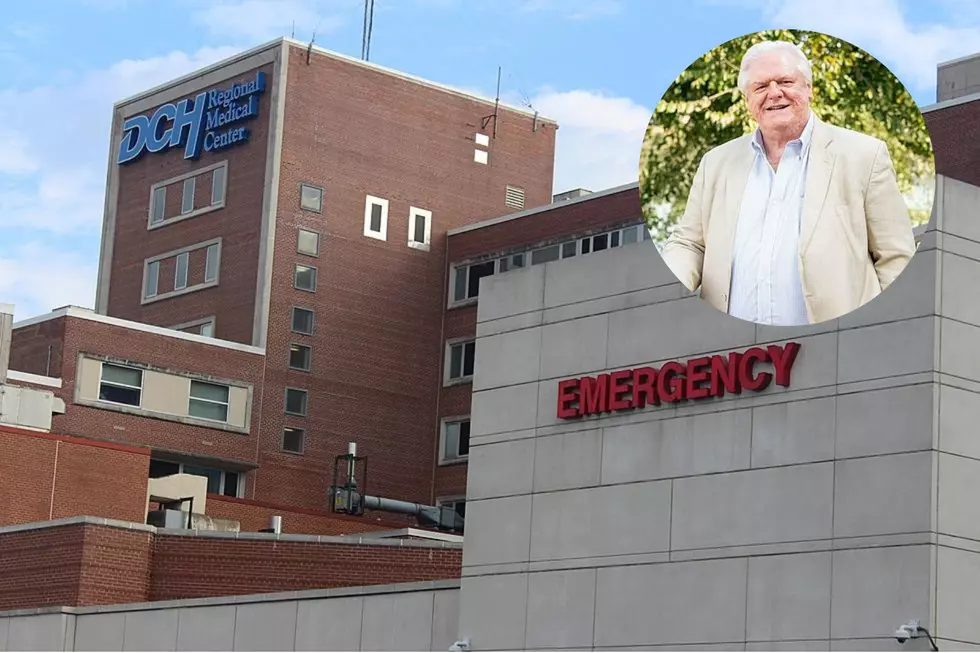
Lawsuit Blames DCH for Wrongful Death of Tuscaloosa Icon Bill Buchanan
A wrongful death lawsuit filed Friday afternoon blames negligence at Tuscaloosa's DCH Regional Medical Center for the death of Bill Buchanan, an area icon who died suddenly last December.
Buchanan, 67, was best known as the Director of Community Development for Tuscaloosa Tourism & Sports but was active all over the area and sat on boards for Theatre Tuscaloosa, the Arts Council and the Kentuck Art Center. He was also an instrumental member of the Tuscaloosa Civil Rights and Reconciliation Foundation and guided the development of the Tuscaloosa Civil Rights History Trail.
The community was shocked when news broke of Buchanan's death days before Christmas 2021.

A new lawsuit obtained by the Tuscaloosa Thread alleges that Buchanan was "doomed" by doctors at DCH who failed to diagnose the root cause of his emergency hospitalization two days before his death.
The lawsuit was filed by Ava Buchanan, Bill's wife of 43 years. It claims he was carrying some dog food from his car into his kitchen when something happened that left him with extreme, stabbing pain in his back and his right leg.
Leon Ashford, the attorney representing Ava Buchanan, said Bill had unknowingly suffered what's called an aortic dissection, or a tear of the inner layer of an artery.
Buchanan's symptoms were severe and worsened quickly, and less than 30 minutes after they developed, he asked Ava to call an ambulance and was rushed to the emergency department at DCH Regional Medical Center in Tuscaloosa around 11 p.m. on December 20th.
Eight Hours in the Waiting Room
Buchanan was suffering from acute lower back pain radiating into his right thigh and had endured several episodes of vomiting and diarrhea. 30 minutes after he arrived at the hospital, his blood pressure was measured at a critically high 202/84.
The physician who triaged Buchanan ordered a CT scan of his abdomen and pelvis, but ordered a test without "contrast," a compound that makes affected tissues and organs appear more clearly on a scan.
At 12:30 a.m. on the 21st, he was given intravenous medicine for nausea and pain.
The scan came back a few hours later and showed Buchanan's spine. It ruled out any abnormality or damage there that could have explained the pain he was experiencing.
At 4:30 a.m., Buchanan was still in the waiting room and the physician ordered that he be placed on a stretcher and given more medicine intravenously.
Ashford said the physician did not physically reassess Buchanan or recognize the implications of his high blood pressure, nausea and vomiting, all of which indicated something more serious than a slipped disk was at play.
After eight hours in the waiting room, Buchanan was finally taken to an Exam Room around 7:30 a.m. on December 21st.
The Failure that Doomed Bill Buchanan
A nurse there noted his symptoms and the medication he had received, but Ashford said her experience "should have alerted her that Mr. Buchanan's clinical status warranted at least hourly rounding, physical reassessments, and close observation because his symptoms persisted despite appropriate medications having been administered."
At 8:30 a.m. on December 21st, nine hours after he arrived by ambulance, the first physician ordered that Buchanan be admitted to the hospital as an "outpatient with observation service" by a second physician who was serving as a hospitalist at DCH.
The first physician documented Buchanan's worsening symptoms, but Ashford asserts she "failed to include or even consider acute aortic dissection in her differential diagnoses" and "this failure doomed Mr. Buchanan."
Boarded in the Emergency Department
Shortly after 10 a.m., the hospitalist examined Buchanan and ordered an inpatient admission requiring acute care. He said Buchanan needed his vitals monitored, hourly rounding check-ins and a check of his lactic acid level, which can be an indicator of septic shock, impaired tissue oxygenation and more.
Ashford said Buchanan's nurses failed to see him hourly, "which would have afforded Mr. Buchanan a timely recognition of the loss of [blood flow] to his right leg."
Buchanan was then reportedly transferred to the acute care section of the emergency department, but not to a room in the main hospital as the second physician had ordered. He reportedly remained "boarded" in the emergency department for 20 hours.
A Critical Result Missed
Around 11 a.m. on the 21st, the level of lactic acid in Buchanan's veins was measured at 7.3 Millimoles per liter, which Ashford called "a critical result" that could have clued his caregivers into the true nature of his emergency.
This major red flag "was apparently not called to the ED and was not addressed by any physician."
Ashford said there is no indication that Buchanan's nurse ever informed the hospitalist caring for him about the elevated level of acid in his blood.
Buchanan's Condition Becomes Critical
For hours, Buchanan remained "boarded" in the emergency department, where his condition worsened.
His blood pressure was falling precipitously by 2:30 p.m. on the 21st, and a second nurse noted at 4:40 p.m. that his leg was immobile, mottled and cool to the touch.
Ashford said at this point, Buchanan had been in the ER for more than 17 hours and had been complaining since his arrival of numbness developing in his leg. The lawsuit says it also appears to be the first time anyone noted that the leg was changing in color and temperature -- all signs that blood flow was decreasing, which Ashford said should have been detected earlier by the first physicians and nurse tasked with diagnosing and treating Buchanan.
"The ED and hospitalist care provided while Mr. Buchanan was held in the emergency department for an extensive period of time was nothing short of fragmented, and it cost him his life," Ashford wrote in his complaint.
A New CT Scan is Ordered But Never Performed
Just before 5 p.m. on the 21st, the hospitalist ordered an ultrasound of Buchanan's leg, which was performed and returned around 7 p.m.
The radiologist reportedly suspected an artery in Buchanan's leg had become abnormally narrow and was restricting blood flow, and the hospitalist entered an order at 7:23 p.m. for an urgent CTA angiogram with runoff.
Ashford says that the scan was never performed -- that at 7:51, Buchanan was finally discharged from the emergency department and admitted to the fifth floor at DCH, where a nurse allegedly canceled the order for the CTA scan shortly after he arrived.
Buchanan Worsens, Codes and Requires Surgery
As the 21st rolled over into the 22nd, Buchanan's condition continued to decline, including "unrelenting" pain and more vomiting. A 2:30 a.m. test of his lactic acid level showed it to be 16.20 Millimoles per liter -- far, far above normal levels.
A vascular surgeon saw Buchanan around 3:45 a.m. on the 22nd and immediately took him to an operating room, where a new CT scan was finally performed.
"As a result of the surgeon's order, almost 12 hours after the CTA was ordered [immediately] by [the hospitalist], the interpreting radiologist confirmed an aortic dissection," Ashford wrote. "By the time the possible dissection was ultimately confirmed, Mr. Buchanan had been at DCH for 31.5 hours."
Buchanan is Transferred to UAB and Dies
When Buchanan's caregivers at DCH realized the extent of the problem, he was airlifted to UAB, where he arrived at 1:33 p.m. on the 22nd. Ashford said at that point, he had no chance of survival.
The lack of blood flow had essentially destroyed his bowel, small intestine and colon.
"The delay in diagnosis at DCH and the resulting delay in treatment of the aortic dissection caused Mr. Buchanan to suffer fatal ischemic injuries," Ashford wrote.
At 3:14 p.m. on the 22nd, Bill Buchanan died at UAB.
The Lawsuit
Now, seven months after his death, Ava Buchanan is suing DCH, the first two physicians who saw him, the companies that contracted those physicians, two of his nurses and a large number of "fictitious" defendants whose identities were not known at the time the suit was filed but who may share liability for Buchanan's death.
The three-count lawsuit "demands judgment against defendants jointly and severally in an amount sufficient to punish the defendants, protect the public, save lives and prevent similar wrong from occurring in the future" as well as "damages which reflect the sanctity of human life and the necessity of preventing simple medical errors that put human life in danger and endanger our families and communities."
A spokesperson for DCH said they could not provide any details about or comments on the case because it involves pending litigation.
For more on this lawsuit as it develops, stay connected to the Tuscaloosa Thread.
Editor's Note: The Thread has elected not to identify the physicians and nurses who are named in this lawsuit, including those named as defendants, to protect their privacy until the case develops further.
This story was published with the approval of Bill's widow and the plaintiff in this case, Ava Buchanan.
Top Stories from the Tuscaloosa Thread (7/18 - 7/25)
12 Tuscaloosa Restaurants and Businesses that Closed in 2022
More From Tuscaloosa Thread









